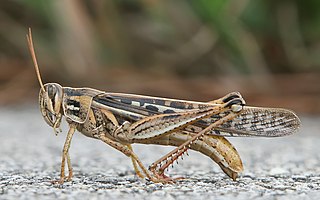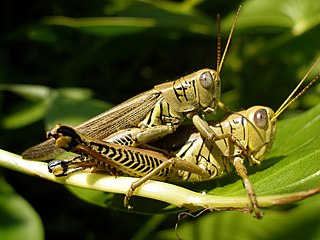
Grasshoppers are a group of insects belonging to the suborder Caelifera. They are amongst what are possibly the most ancient living groups of chewing herbivorous insects, dating back to the early Triassic around 250 million years ago.

The grasshopper subfamily Acridinae, sometimes called silent slant-faced grasshoppers, belong of the large family Acrididae in the Orthoptera: Caelifera.

The Caelifera are a suborder of orthopteran insects. They include the grasshoppers and grasshopper-like insects, as well as other superfamilies classified with them: the ground-hoppers (Tetrigoidea) and pygmy mole crickets (Tridactyloidea). The latter should not be confused with the mole crickets (Gryllotalpidae), which belong to the other Orthopteran sub-order Ensifera.

Tetrigidae is an ancient family in the order Orthoptera, which also includes similar families such as crickets, grasshoppers, and their allies. Species within the Tetrigidae are variously called groundhoppers, pygmy grasshoppers, pygmy devils or "grouse locusts".

The genus Helwingia consists of shrubs or rarely small trees native to eastern Asia, the Himalayas, and northern Indochina. It is the only genus in the family Helwingiaceae.

The differential grasshopper is a species of grasshopper belonging to the genus Melanoplus. It is found throughout northern Mexico, the central United States and southern Ontario, Canada. It is considered a pest over most of its range.

Melanoplus bivittatus, the two-striped grasshopper, is a poikilothermic species of grasshopper belonging to the genus Melanoplus. It is commonly found in North America, with high quantities inhabiting Canadian prairies and farmland.

Vitis sinocinerea, commonly known as the lobular grape or small-leaved grape, is a species of climbing vine in the grape family ranging widely over much of the Chinese mainland as well as Taiwan. In Chinese it is known as xiao ye pu tao, which can be translated as small-leaved grape. Its natural habitat is within forested or shrubby hills.

Atractomorpha is a genus in the Pyrgomorphidae, a family of grasshoppers, found in Africa, Asia, and Australia.

Biston suppressaria, the tea looper, is a moth of the family Geometridae. It is found in China, India, Myanmar, Nepal, and Sri Lanka.

Eumastacidae are a family of grasshoppers sometimes known as monkey- or matchstick grasshoppers. They usually have thin legs that are held folded at right angles to the body, sometimes close to the horizontal plane. Many species are wingless and the head is at an angle with the top of the head often jutting above the line of the thorax and abdomen. They have three segmented tarsi and have a short antenna with a knobby organ at the tip. They do not have a prosternal spine or tympanum. Most species are tropical and the diversity is greater in the Old World. They are considered primitive within the Orthoptera and feed on algae, ferns and gymnosperms, the more ancient plant groups.

Chorotypidae is a family of tropical Asian grasshoppers, formerly included within the family Eumastacidae. These grasshoppers have a head that rises above the level of the thorax and short antennae. Some species have reduced wings, others have wings that widen towards the tips and still others have a flattened leaf-like shape. They lack abdominal tympani.
Eudonia microdontalis is a moth in the family Crambidae. It was described by George Hampson in 1907. It is found in Japan, China and Russia.

Anacridium moestum, the camouflaged tree locust, is a species of grasshopper belonging to the family Acrididae, that is native to Africa south of the equator. It is similar in appearance to the Southern African desert locust, Schistocerca gregaria flavicentris. It is likewise brownish, large and slender, but mostly arboreal in its habits.

Xenocatantops humilis is the type species of grasshoppers in its genus, belonging to the family Acrididae and subfamily Catantopinae.
Gonista is a genus of grasshoppers in the family Acrididae, subfamily Gomphocerinae, and tribe Ochrilidiini; species are distributed in China and SE Asia.
Sinstauchira is a genus of grasshoppers in the subfamily Catantopinae, not assigned to any tribe. Species can be found in southern China and Vietnam.

Megaulacobothrus is a genus of grasshoppers in the tribe Stenobothrini. Species have been recorded from northern and Temperate Asia.
Atympanum is a genus of grasshoppers in the subfamily Oedipodinae, from China.
Oxytauchira is a genus of grasshoppers (Acrididae) in the subfamily Oxyinae. The known distribution of species is: India, southern China, Indochina, Java and Sulawesi.













